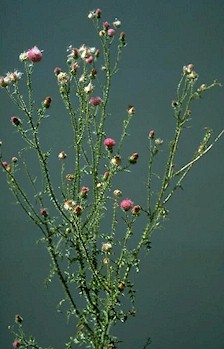plumeless
thistle
(Carduus
acanthoides)
 Photo By: Washington State
Noxious Weed Control Board
Photo By: Washington State
Noxious Weed Control Board
Roots:
The roots of the plumeless thistle are large wide spreading
taproots. (2)
Stems/ Leaves: The stem of the
plumeless thistle is stiff, and it may grow to more than 5 feet
high. The stems are usually only about 1 to 4 feet tall.
The stem containes many branches off of it all the way up the top.
(1) The leaves are similar to that of the musk thistle, but
the
plumeless thistle leaves don't have the white border around them.
The leaves are also a lot skinnier than those on a musk thistle.
The leaves also usually are about 6 inches long. (2)
Flowers: The flowers of the
plumeless thistle are very small (usually between 1/2 inch and 1 inch
in diameter). The flowers are numerous and are a bright pink or
purple in color. The flowers may be by themselves or in
clumps. These plants usually flower between May and August. (2)
Fruits and Seeds: Plumeless
thistle do not bear fruit. The seeds are relatively small, and
usually grey or tannish in color. The look a lot like a sunflower
seed without the shell on it. (1)
Reproduction: Plumeless
thistle reproduces when the seeds off of the flowers.
They are usually spread by the wind and by animals. (2)
Lifestyle/Habits/Life Duration: Plumeless
thistle is a winter annual or biennial. (2)
Environments Favorable to Infestation:
The areas that plumeless thistle is most often found in are in
dry pastures, along roadsides, and also in creek bottoms. (3)
Methods of Control:
Biological Control: The three
main insects are used to kill
plumeless thistle are the seed-head weevil (Larinus planus), rosette bud
weevil (Trichosirocalus harridus),
and the
seed-head gall fly (Urophora
quadrifasciata). They
are all effective at different
stages. For example the seed-head weevil is only useful when the
plumeless thistle flowers for the first time. (4)
Cultural Control: Having
healthy plants that are wanted in that area (a healthy plant community)
do help choke out
plumeless thistle. (3)
Mechanical Control: Digging,
pulling, and mowing plumeless thistle is somewhat effective as long as
these methods are done before the plant flowers and goes to seed.
These methods are effective because the seeds are the only way
plumeless thistle can be spread. (3)
Bibliography:
1) Plumeless Thistle.
www.aspenpitkin.com. 10 February 2006,
<http://www.aspenpitkin.com/misc/weeds/plumeless_thistle.htm>.
2) Plumeless thistle.
www.ag.ndsu.nodak.edu. 11 February 2006,
<http://www.ag.ndsu.nodak.edu/invasiveweeds/plumeless.htm>.
3) "Carduus acanthoides." Plumeless
Thistle. www.blm.gov. 11 February 2006,
<http://www.blm.gov/ca/alturas/plumthis.html>.
4) Nodding and Plumeless
Thistle. res2.agr.gc.ca. 13 February 2006,
<http://res2.agr.gc.ca/lethbridge/weedbio/plant/bnodplum_e.htm>.
 Photo By: Washington State
Noxious Weed Control Board
Photo By: Washington State
Noxious Weed Control Board Photo By: Washington State
Noxious Weed Control Board
Photo By: Washington State
Noxious Weed Control Board